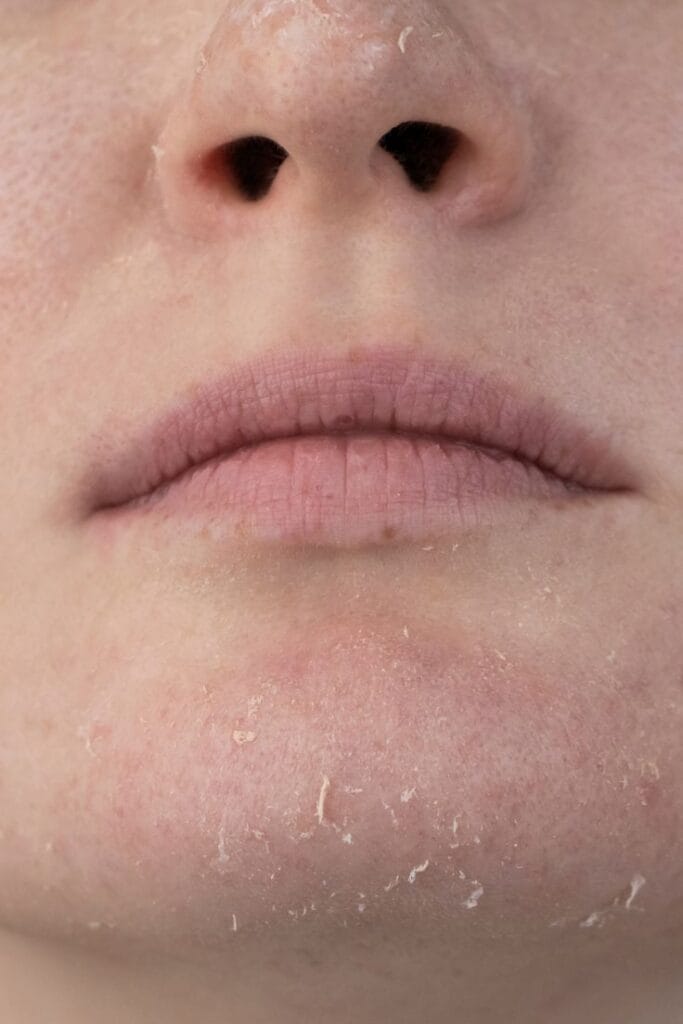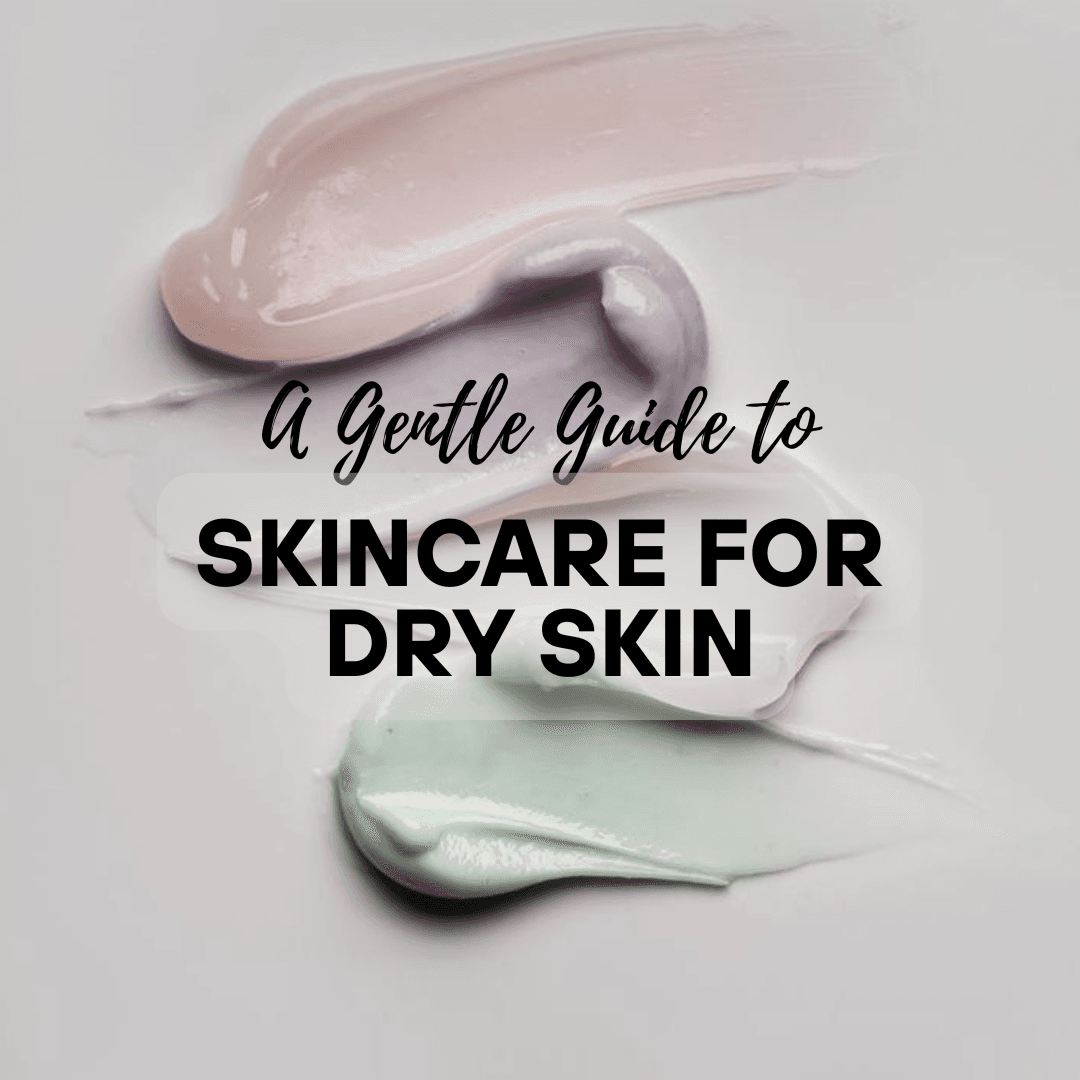Skincare for dry skin is important for maintaining softness, hydration, and comfort. Without the right care, dry skin can lead to tightness, flakiness, and dullness.
However, with the right approach, you can restore moisture and protect your skin’s natural barrier.
To begin with, everything comes down to using the right ingredients like hyaluronic acid, beneficial oils, and ceramides that help lock in hydration and support a calm, well-nourished complexion.
By choosing wisely, a simple, effective routine that includes gentle cleansers, hydrating serums, and protective sunscreen will leave your skin feeling refreshed and nourished.
In this guide, you’ll learn how to build seamless skincare for dry skin, with steps designed to bring back comfort and moisture to your skin every day.
Let’s Talk Dry Skin 
First, it’s important to understand what dry skin means. Dry skin is a skin type that naturally lacks oil and struggles to retain moisture. It every so often feels tight, rough, or itchy and may seem dull or flaky, particularly during colder months or in dry indoor environments.
It’s important to note that dry skin differs from dehydrated skin, which lacks water. Both need care, but in somewhat different ways.
When your skin is dry, its barrier becomes more delicate, making it easier for moisture to escape and irritants to sneak in.
This often causes sensitivity, fine lines, and a rough texture. Factors like genetics, aging, weather, and harsh skincare products can all make dryness worse.
Identifying these signs early on is key. If your skin feels uncomfortable after washing, flakes easily, or absorbs moisturizer too quickly, chances are you’re dealing with dry skin, and it’s time to start skincare for dry skin with the gentle, targeted care it needs.
Essential Ingredients for Dry Skin
When it comes to creating a deeply nourishing skincare regimen for dry skin, the ingredients you choose are just as important as the steps you follow.
Dry skin flourishes with formulas that restore moisture, protect the skin barrier, and offer long-lasting comfort.
Below are some of the most effective ingredients to keep an eye out for:
Hyaluronic Acid
A powerful humectant that attracts water to the skin, hyaluronic acid is a must-have for deep hydration. It helps plump the skin and smooth out fine lines, making it feel soft and dewy.
Ceramides
Ceramides are lipids that occur naturally in your skin. They strengthen the barrier, helping to lock in moisture and keep irritants out. In particular, products with ceramides are especially helpful for soothing flaky skin and reducing tightness.
Glycerin
Glycerin is gentle yet effective, and draws moisture from the air into your skin. Moreover, it complements other hydrating ingredients beautifully to maintain lasting comfort.
Squalane
This lightweight face oil mimics your skin’s natural oils. Because of this, it’s excellent for sealing in hydration without feeling greasy. It also supports elasticity and improves texture.
Aloe Vera
Aloe Vera is known for its calming and moisturizing properties. It is perfect for sensitive or irritated dry skin. It also has a cooling effect that soothes redness and discomfort.
Niacinamide
This multitasking ingredient reinforces the barrier, evens out skin tone, and reduces redness. Additionally, it helps improve skin texture without causing dryness or irritation.
Steps to Soothe & Nourish Dry Skin
Now that you’re familiar with what dry skin truly needs, let’s walk through an easy-to-follow skincare routine for dry skin that supports long-term hydration and balance.
Each step in this routine plays a specific role in delivering moisture, reducing irritation, and keeping your skin barrier strong.
Here’s how to structure a simple yet effective routine for dry skin:
Gentle Cleanser (Morning & Night):
Start and end your day with a mild, hydrating cleanser that doesn’t strip your skin. Avoid foaming or alcohol-based formulas, as they can worsen dryness.
Instead, look for creamy or lotion-based cleansers with ingredients like glycerin, ceramides, or aloe vera.
Hydrating Toner or Essence: 
Next, after patting your skin dry, apply a lightweight hydrating toner or essence to prep your skin for better absorption. Choose formulas that include hyaluronic acid, rice extract, or ginseng.
Serum with Active Ingredients:
Then, layer on a hydrating serum, preferably one rich in hyaluronic acid, niacinamide, or panthenol. These ingredients penetrate deeply and draw moisture into the skin while highlighting the barrier.
This step is key in any effective dry skincare routine.
Rich Moisturizer:
Then, lock in all the goodness with a moisturizer. For dry skin, choose one with emollients like squalane, shea butter, or lanolin, and humectants like glycerin.
SPF Protection (Morning Only):
In the morning, always follow up with sunscreen. Even dry skin is prone to UV damage, which can cause flakiness and weaken the skin barrier.
Look for mineral-based options with zinc oxide or fusion water SPF for gentle but effective protection.
Face Oil or Overnight Mask (Optional):
Finally, for an extra boost, you can apply a face oil or use a hydrating overnight mask a few times a week.
Oils like jojoba or rosehip mimic your skin’s natural oils, while hydrating masks infused with aloe vera or ceramides help repair and soothe skin overnight.
Skincare Tips
Beyond your daily routine, small adjustments can make your skincare regimen for dry skin more impactful.
By adjusting how and when you apply products and being mindful of your environment, you can maintain long-lasting moisture and comfort.
Here are a few simple tips to enhance your skincare for dry skin:
Avoid Hot Water:
Hot water might feel soothing, but it strips away your natural oils. Go for lukewarm water instead, it’s much kinder to your skin barrier and helps prevent extra dryness.
Apply to Damp Skin:
After cleansing, gently pat your skin, but don’t dry it completely. Applying your hydrating serum or moisturizer on damp skin helps seal in more hydration, giving your face a smoother, softer finish.
Use Products in the Right Order:
Layering matters! Start with lighter hydrating products like hyaluronic acid, then follow with richer creams or oils to lock in moisture.
This step-by-step layering ensures your skin gets the most from each ingredient.
Watch for Harsh Formulas:
Avoid products that contain strong fragrances, alcohol, or stripping acids. These can irritate sensitive skin and weaken the skin barrier. Always read the label and choose formulas made for dry skin care.
Add Moisture to the Air:
Dry indoor air, especially from heaters or air conditioning, can pull moisture from your skin. Using a humidifier helps maintain hydration and supports your skin overnight.
Choose Makeup That Supports Your Skin:
Go for makeup products with hydrating ingredients. Creamy textures work better than mattes, which can highlight dry patches. A dewy finish often makes dry skin look healthier and more radiant.
Stay Hydrated & Nourished:
Drinking enough water, eating healthy fats, and choosing foods with vitamin E or ceramides can all help improve skin hydration. Beauty truly starts from within.
When It’s More Than Dry Skin
Sometimes, what feels like dry skin can be a sign of something more. If your usual skincare for dry skin doesn’t seem to help or if you notice symptoms like redness, inflammation, or constant flaking, it may be time to dig a little deeper.
Conditions like eczema, psoriasis, or contact dermatitis often appear similar to dry skin but need different care. These skin issues may require prescription treatments, medicated creams, or a visit to a board-certified dermatologist for proper diagnosis and support.
Here are a few signs that you might be dealing with more than just dry skin:
- Persistent itchiness or discomfort even after moisturizing
- Red patches or bumps that don’t fade with regular care
- Cracks or open skin that sting or burn
- Flare-ups that worsen in specific environments or with certain products
If these signs sound familiar, it’s best not to self-diagnose. While a gentle dry skincare routine can help soothe some symptoms, medical skin conditions need targeted solutions.
Heeding your skin and recognizing when it needs expert care is just as important as following the right routine.
After all, healthy skin starts with understanding its true needs.
Seasonal Effects
Your skincare for dry skin shouldn’t stay the same all year. As the weather changes, so do your skin’s hydration needs.
Seasonal changes can affect moisture levels, texture, and overall comfort, especially if you already deal with dryness.
Winter Woes
Cold air, indoor heating, and low humidity levels often lead to tightness, flakiness, and irritation.
According to Dr. Joshua Zeichner, a board-certified dermatologist, switching to richer moisturizers and layering hydrating products can help your skin stay strong. You might also consider adding a nourishing face oil and a humidifier to maintain indoor moisture.
Summer Stress
While summer air is more humid, skincare for dry skin still matters. Excess sun, sweat, and UV exposure can weaken the skin barrier. Choose lightweight, non-stripping formulas and don’t skip sun protection. A broad-spectrum sunscreen is great for sensitive or dry skin types.
Spring & Fall Shifts
These transitional months often bring unexpected dryness or irritation. Focus on balance, keep using gentle moisturizers, hydrating serums, and barrier-loving ingredients like ceramides or niacinamide.
If your skin feels off, scale back on actives and lean into soothing products.
By adjusting your dry skin care routine with the seasons, you’ll keep your skin calm, hydrated, and happy.
FAQs
Why is my skin still dry after skincare?
You might be using harsh products or skipping moisturizer on damp skin. Gentle, hydrating skincare for dry skin helps lock in moisture.
What skincare helps dry skin the most?
Go for hydrating cleansers, hyaluronic acid, and ceramide-rich moisturizers. These are essentials in skincare for dry skin.
What’s the best skincare for dry skin with hormonal acne?
Use non-comedogenic, hydrating products and spot-treat gently. Balance is key in skincare for dry skin with acne.
How can I care for dry skin with large pores?
Exfoliate gently and hydrate daily to improve skin texture. A good dry skin skincare routine helps refine pores.
What is a good dry skin skincare routine?
Cleanse, hydrate, moisturize, and protect with SPF. Stick to soothing, moisture-rich products in your skincare for dry skin.
What’s the ideal skincare for dry skin in summer?
Use lightweight hydrators and always wear sunscreen. Summer-friendly skincare for dry skin keeps the barrier protected.
How should I change my skincare for dry skin in winter?
Switch to richer creams and avoid hot water. Winter skincare for dry skin should focus on deep hydration and barrier repair.
What’s the best skincare routine for dry skin in your 30s?
Add antioxidants and barrier-supporting ingredients. Skincare for dry skin in your 30s should hydrate and protect.
Final Words
Taking care of dry skin doesn’t have to be complicated. With the right skincare for dry skin, you can restore moisture, protect your skin’s barrier, and achieve a healthy, hydrated glow. Remember to use products with ingredients like hyaluronic acid, ceramides, and nourishing oils, and always be gentle with your skin.
If you’re coping with dry skin and need personalized tips or product recommendations, don’t hesitate to explore our detailed skincare guides and find the best routine for your needs.
Furthermore, check out our guide to create the perfect skincare routine for oily skin and keep your complexion balanced and clear!

No responses yet